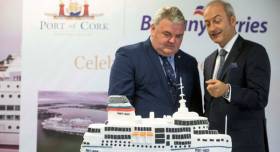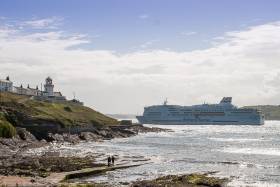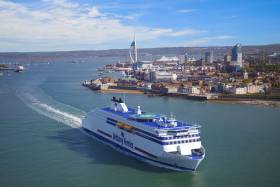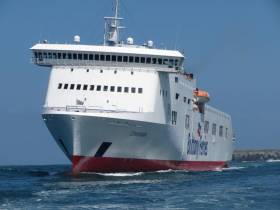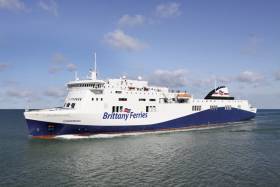Displaying items by tag: Brittany Ferries
#FerryNews - Trying to help people is Britanny Ferries with those who booked with Irish Ferries WB Yeats, but may not be able to accommodate many because they are nearly full for July and August.
As the Irish Examiner writes, Brittany Ferries chief executive Christophe Mathieu said some people who had booked trips to France with Irish Ferries had rebooked with his company for the Cork-Roscoff route, but space is now nearly at a premium.
Around 19,000 people have had their summer sailings to France cancelled due to a delay in the delivery of a new ferry to Irish Ferries.
Mr Mathieu made the comments yesterday at a special reception in Ringaskiddy, Co Cork, which marked 40 years since Brittany Ferries opened its Cork-Roscoff service.
“Brittany Ferries was only five years old when we launched services linking Roscoff and Cork back in 1978. In our first year of operations we carried just under 22,000 passengers on the MV Armorique,” said Mr Mathieu.
The newspaper had more here on the new Ireland-Spain service and the impact of Brexit.
In May 1978 Brittany Ferries launched their Cork-Roscoff ferry route from Cork City Quays with their flagship MV ‘Armorique’. At the time, all ferries departing Cork used the passenger terminal at Tivoli, before being transferred downriver to the dedicated Ringaskiddy Ferry Terminal which opened in 1982. Since then the passenger and freight route linking Ireland and France has gone from strength to strength and today the Port of Cork acknowledged this service by wishing Brittany Ferries a Happy 40th Anniversary linking the two countries.
Port of Cork Chairman, John Mullins said: ‘It is with great pleasure that today we wish our long-term customer, Brittany Ferries, a very happy 40th anniversary linking Ireland and France. This company has shown true dedication in providing a reliable and attractive ferry service for both passengers and freight. On behalf of the Port of Cork I would like to congratulate Brittany Ferries on the last the 40 years’ service and wish them every success for the next 40 years.’
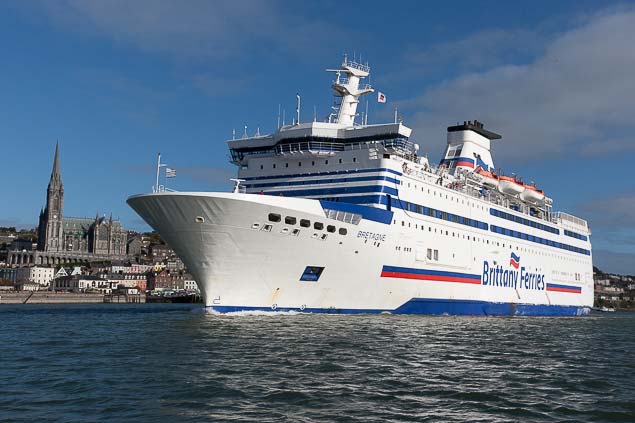 Britanny Ferries Bretagne off Cobh in Cork Harbour Photo: Bob Bateman
Britanny Ferries Bretagne off Cobh in Cork Harbour Photo: Bob Bateman
Over the last 40 years Brittany Ferries have become the market leader on the Western Channel for passengers and freight and in 2018 this commitment was further endorsed when Brittany Ferries announced the first ever ferry service linking Ireland and Spain, with the new Ro-Pax twice-weekly service from Cork to Santander. As well as serving Cork to Santander, this route also delivers an additional weekly return-sailing from Cork to Roscoff.
The new Ro-Pax ferry service was welcomed by the Port of Cork which has brought an increase in Spanish tourism to Cork and provides a very useful connection for exporting freight from Ireland to mainland Europe. This new service, the first direct service from Ireland to Spain, will offer the option for freight carriers and passengers to bypass the UK and French land-bridge to Spain as Brexit uncertainty continues. The Port of Cork hinterland is the key primary pharma, agriculture and food & drink output region in the country. This more efficient supply chain will offer freight customers a direct route to market enabling them to get their produce to market quicker than if they travel through traditional ports.
In 2017, Brittany Ferries carried more than 87,000 passengers, which was an increase of 4% on the previous season and contributing to the national economy. While France continues to be a popular travel destination for Irish travellers, the number of French people visiting Ireland showed no signs of waning as nearly 45,000 availed of the route, representing 52% of all passengers carried.
#FerryNews - Brittany Ferries has confirmed recently the charter of two brand new cruise-ferries to serve its long-haul UK to Spain routes.
Both ships adds Afloat are of the Stena E-Flexer design (see Stena Line Irish Sea debut in 2020) that will be built at the Avic International Weihai shipyard in China, with the first arriving in time for Brittany Ferries on the 2021 holiday season.
The latest investment underlines the company’s commitment to Portsmouth and to its Spanish routes. It comes after work began this spring on a brand new LNG (liquefied natural gas) cruise ferry called Honfleur to serve its most popular Portsmouth – Caen crossing. Like Honfleur, which arrives in 2019, both ships announced today will be registered under the French flag and will be crewed by French seafarers.
Together the three ships will spearhead a wide-ranging, five-year fleet-renewal and modernisation programme worth around £400m.
Portsmouth is Brittany Ferries’ UK hub and will serve as the base for both ships. Upon arrival they will cater for an ever-increasing demand for long-haul ferry travel to Spain. In 2017 the company operated 844 sailings on routes from Portsmouth, Poole and Plymouth to Santander (Cantabria) and Bilbao (Basque Country), carrying 331,000 passengers and 150,000 cars. That was around 80 per cent more than ten years earlier.
“Spain is by far the most popular foreign destination for UK holidaymakers, and we have seen significant growth in demand,” said Jean-Marc Roué, Brittany Ferries’ president. “Post-Brexit, we expect this to continue and today’s announcement is a clear statement of intent. As well as passenger traffic, we believe that an increase in freight capacity will open the door to more hauliers seeking direct access between Britain and the Iberian peninsula.”
Last year, Brittany Ferries carried around 40,000 freight units from UK to Spain. Lorry drivers are able to relax as the sea takes the strain, reducing fuel costs, tolls and road pollution that comes from driving long-haul through France.
Measuring 42,400 tonnes and 215 metres long, the new vessels will be the longest in Brittany Ferries’ fleet. If Portsmouth’s Spinnaker Tower were laid on its side, each would outstretch it by 45 metres. These impressive dimensions will allow them to carry almost two miles of freight vehicles apiece.
The new ships are being chartered from Swedish shipping company Stena RoRo, as part of its new generation of state-of-the-art ‘E-Flexer’ vessels. Both will be gas-ready and promise a combination of luxury and Spanish style. “These ships will be like twins,” added Catherine Querné, Brittany Ferries strategy director. “Outwardly, they will have the same dimensions and shape, but they will be dressed very differently. And of course each will have its own unique personality.”
There will be plenty for passengers on board. Three spacious passenger decks will host boutiques, a café, restaurant, bar and an exclusive club lounge. Around 300 en-suite cabins will cater for approximately 1,000 passengers and many will be adapted for customers with disabilities, as well as those travelling with their pet dog or cat (Brittany Ferries carries around 70,000 annually).
Elegant décor will ensure everyone feels in the holiday mood as soon as they step on board. Brittany Ferries will be working with Spanish interior designers to give the ships a stylish, modern feel and feel, evoking the golden coasts, verdant landscapes and vibrant towns of España Verde (Green Spain) on the northern coastline.
The announcement follows the launch of the first ever direct ferry service linking Ireland with Spain when Brittany Ferries’ Connemara made its first Cork-Santander sailing with an arrival to the northern Spainish port on 10 May 2018.
The year 2018 also marks 40 years of continuous services linking Britain with the Iberian Peninsula. Since 1978 more than 5.5 million passengers have enjoyed Spain without the ‘plane thanks to Brittany Ferries.
Technical specifications:
Length 214.5m
Breadth 27.8m
Draught 6.4m
Tonnage 42,400
Service speed 22 knots
Decks 10
Passengers 1,000
Passenger cabins Around 300 plus 36 for freight drivers
#FerryNews - Connemara, Brittany Ferries chartered ropax completed a maiden Cork-Santander crossing this afternoon, marking the historic first arrival of an Ireland-Spain ferry service, writes Jehan Ashmore.
Under glorious blue skies, Connemara arrived into Santander Bay and docked at the Muelle del Almte with the backdrop of the Cantabrian mountains of northern Spain. The 500 passenger / 120-cabin capacity ropax can take between 80-100 cars and 100 freight trailers. The direct route is a game-changer for tourists and hauliers and notably in a looming post-Brexit environment in addition to enhancing cultural ties between Ireland and Spain.
Brittany Ferries operates Connemara on the 26-hour crossing and based on a twice weekly overnight sailings, departing Cork on Wednesdays (see yesterday's coverage) and Fridays. The return sailings from Santander are on Sundays and Thursdays. The new service has been a strategic goal for the Port of Cork Company when plans were made to establish the link since 2004 that involved discussions with other ferry operators and another port in northern Spain.
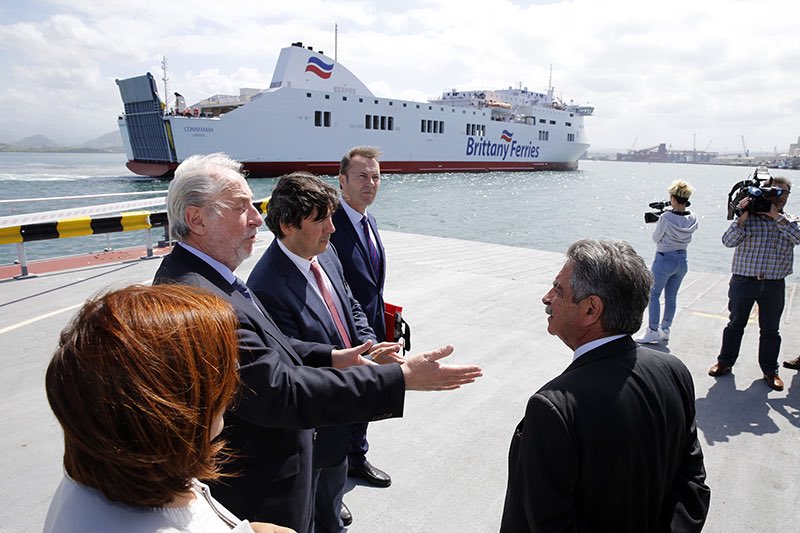
Above: Connemara arrives in Santander this afternoon with officials from Gobierno de Cantabria, the regional authority of the autonomous community. The officials stand on the ferry's ro-ro berth linkspan located on the quay of the ferry terminal (Photo: Government of Cantabria - twitter)
Among the sold-out inaugural économie 'no-frills' which only caters for motorists passengers were fans of Leinster Rugby. They are heading for the European Rugby Champions Cup final in Bilbao to be held on Saturday where they play French team Racing 92 from Paris.
Also driving off the 195 vehicle ferry onto Spanish soil were an impressive array of supercars worth millions of euro. They involved Bentleys, BMW's, McCLarens and Lamborghinis. The cavalcade of high-performance cars are to embark on a 3,000km, 10-day fundraising tour throughout Spain in aid of childrens’ charity the Bubblegum Club.
Brittany Ferries are no strangers to the Cantabrian port having established four decades ago a direct service from the port to the UK. This began with a Plymouth-Santander service in 1978.
In the same year the French ferry company launched the Cork-Roscoff route in which Connemara also carries out a single weekday round-trip service again based on the no-frills concept. The Ireland-France route taking 14 hours is also operated by flagship Pont-Aven which has sailings based on cruiseferry standards.
New Direct Ireland-Spain Service Delayed to Next Weekend
#FerryNews - The new Cork-Santander route, the first ever direct ferry service connecting Ireland and Spain, originally scheduled to start today, has been delayed to next weekend, writes Jehan Ashmore.
Afloat had noted the change of sailings and confirmed with operator, Brittany Ferries which commented that Connemara’s entry into service has been slightly delayed in order to allow our technical teams at the Astander shipyard (in Santander) all the necessary time to prepare the ship fully.
Brittany Ferries added the new route's first sailing will now be at 12.00 on the Santander-Cork route on Sunday 6th May, a week later than scheduled. Afloat adds that the revised inaugural Cork-Santander sailing is scheduled for a departure at 11.00 on Wednesday, 9th May.
Afloat also highlights that the Irish-Iberian route operating to an 'économie' no-frills service does not take 'foot' passengers on the twice-weekly operated service.
In the interim period between the first inward bound sailing to Ireland and of the first outward sailing to northern Spain, Connemara is also scheduled to make a debut on the Cork-Roscoff route that this years celebrates a 40th anniversary. The 14 hour route since 2004 is operated by flagship Pont-Aven, providing cruiseferry services at weekends.
Connemara will also introduce new capacity on the Ireland-France link (in the lead up to Brexit) by operating a single weekday round trip. These additional sailings are also based on the économie' service and include 'foot' passengers unlike the Spanish service.
In what will be a historic occasion, the launch of the Connemara connecting Cork and Cantabrian city of Santander is a game-changer. The crossing taking around a day, brings benefits to tourism in both directions but also freight bypassing on Ireland-France links and avoiding the long distance drive south to Spain and Portugal.
As previously reported in January, the new continental route sees Brittany Ferries charter Connemara from Stena RoRo.
The previous charter of the 500 passenger/195 car /120 cabin ropax as the Asterion was to ANEK Lines on a Italy-Greece service, but the 27,415 gross tonnage ropax is no stranger to the Bay of Biscay. Then as Norman Asturias, the ropax operated GLD Atlantique (later LD Lines) St. Nazaire-Gijón route in recent years though no longer exists nor does the operators onward link to Ireland between St. Nazaire and Rosslare Harbour.
The 2007 Visentini shipyard built Asterion this week arrived from Greece to Santander for dry-docking and also be renamed Connemara. Another Irish connection is fastferry, Jonathan Swift which Irish Ferries sold. The high-speed craft (HSC) which when departing Dublin yesterday was understood to be renamed, Cecilia Payne arrived also in northern Spain this morning but further to the west in La Coruña, Galicia.
The en-route call of the Austal-Auto Express 86m catamaran, likely to be for bunkers, is to continue on a delivery voyage to the Mediterrranean. A new career for the craft beckons between Spain and the Balearic Islands.
Returning to Connemara, the Cypriot flagged 186m ropax is at Astander's No. 2 dry-dock in El Astillero (near Santander). Connemara becomes Brittany Ferries first vessel to be named with an Irish connection. Compared to the rest of the fleet that in the majority are named after scenic locations and towns in Brittany and neighbouring Normandy.
Connemara is not Brittany Ferries first 'économie' service as the concept was introduced in recent years on the Portsmouth-Le Havre route. This is one of the operators five services on the English Channel.
#FerryNews - Brittany Ferries resumed seasonal Cork-Roscoff service this Easter Bank Holiday, the sailings also celebrated the 40th anniversary of the route, writes Jehan Ashmore.
The 41,700 gross tonnage flagship, Pont-Aven launched the Ireland-France season having arrived in Roscoff yesterday morning. The 14 hours crossing marked the completion of the first round trip of the season that began on Friday night.
The 2,400 passenger/650 car capacity cruiseferry operates on what continues to be the shortest fastest route to France which has proved popular with Irish holiday-makers.
In 2017, Brittany Ferries carried more than 87,000 passengers, which was an increase of 4% on the previous season and contributing to the national economy. While France continues to be a popular travel destination for Irish travellers, the number of French people visiting Ireland showed no signs of waning as nearly 45,000 availed of the route, representing 52% of all passengers carried.
The service which asides providing a convenient direct route to the continent has also developed strong cultural ties between Ireland and France. This year sees the launch by Brittany Ferries économie no-frills Mondays sailings from Cork (from 30 April) in tandem to the flagship's routine Saturday service.
Brittany Ferries as previously reported are to launch the first ever direct Ireland-Spain route, Cork-Santander service starting on 2 May. A chartered in ropax, Connemara will operate the Bay of Biscay route and based on an économie no-frills service.
Rolling back the years and prior to the launch of the Cork-Roscoff route in May, 1978, a special promotional visit to Cork City centre quays took place on St. Patrick's Day. This involved the arrival of the 5,372 tonnes flagship Armorique.
The sleek profile of this 1972 French built ferry, the former Terje Vigen, was acquired three years later by the operator and renamed Armorique. The ship named after the Armorique Natural Park stretches from the Altantic Ocean to inland countryside. As for the ships' stylish lines combined with the French novely factor drew large crowds of curious Corkonians along the South Custom Quay, opposite Cork City Hall. On board were representatives from Brittany that travelled over and took part in the annual festival parade.
In addition a fleetmate, albeit even smaller, Penn-Ar-Bed made a special trip too that month to Cork and again to the same quay. The maiden commercial voyage was performed by Armorique on 27 May and proved an instant success with holidaymakers and freight. The venture paid off and had defied the critics at the time as to its viability.
The Armorique with a 700 passenger capacity and space for 170 vehicle decks, carried the vast majority of traffic as the end of season sailings were operated by Penn-Ar-Bed. This custom-built ferry of a mere 2,981 tonnes could only handle 420 passengers and 160 cars.
At the end of the first season, the Breton based operator announced that carryings were so encouraging and that they would in 1979 charter a freight-only ferry, Normandia. This allowed all freight to be carried separately and free-up space for passengers and holiday-based motorists on Armorique.
Services then used the former ferryport terminal in Cork at Tivoli downriver of the city, before operations transferred to the current Ringaskiddy Terminal in lower Cork Harbour. In the four decades of the Roscoff service, there have been 14 ferries, some appearing under different names. Also the role of three freight ro-ro ships operating the route.
Some ships it should be added made a once-off call to Cork (see Duc de Normandie) due to providing relief cover for routine ships going for dry-dock. This ferry for example had been deployed from the operators France-UK network which includes direct UK-Spain services.
The network in 1978 comprised of 5 routes, this included the launch of a new direct UK-Spain route, Plymouth-Santander. Over the past four decades the network has expanded to more than double the number of routes linking the four nations.
White-Hot As Plasma Splits Steel for Brittany Ferries English Channel Newbuild Honfleur
#FerryNews - It was getting white-hot as plasma jets cut through sheets of steel for Brittany Ferries English Channel newbuild cruiseferry Honfleur at the FSG shipyard Germany, which is completing Irish Ferries W.B. Yeats due to enter service this summer.
The steel cutting ceremony of Brittany Ferries’ Honfleur on Monday, marked the first step of the cruiseferry that will take little over a year to complete. By June 2019, the metal being cut will form part of a complex and complete 42,400 gross-tonne vessel, powered by liquefied natural gas (LNG), making her first crossing from Portsmouth to Caen, Normandy.
“This is a very exciting day for everyone at Brittany Ferries,” commented Christophe Mathieu, Brittany Ferries CEO speaking from the yard. “In little over one year, a mighty ship will rise, ready to carry passengers in comfort, style and on the cleanest vessel regularly operating on the Channel. Today’s ceremony is like a glimpse into the future of sustainable ferry travel. It is a future that is not so far away for millions of holidaymakers and freight customers.”
Brittany Ferries will tell the story of the build through a new website, www.destinationhonfleur.com . It will host regular news updates, video interviews and a stunning gallery featuring shipbuilding and destination imagery, all free to download in high res.
Steel cutting, of course, is not the start of the process. Before Honfleur is built in steel, she is built virtually. Every other cut and weld has been carefully planned, along with the countless other operations required to build such a complex craft. For shipbuilding in the 21st century is as much about CAD design, complexity management and logistics as it is about forming steel.
When complete, Honfleur will carry up to 1,680 passengers, 550 cars and 64 trailers and come with 261 cabins, two cinemas, restaurants, boutique shopping and expansive passenger lounges. Wi-Fi will come as standard in all areas of the ship, including cabins and access from the car decks to passenger areas will be made as easy as possible for all passengers.
She will be the first ferry regularly operating on the English Channel, powered by LNG (liquefied natural gas). This fuel emits less carbon dioxide during combustion than diesel and burns with no smoke. It is entirely free of sulphur and produces very low emissions of nitrogen oxide and particulate matter. Her dual fuel engines coupled with LNG-electric propulsion will bring further efficiency, as well as a smoother and quieter ride for passengers.
Overseeing the project is naval architect Brice Robinson, working on his fifth vessel for the company. He is based in Germany with a team for the duration of the build. “Building a ship is a little like cooking,” he summarised. “It’s a recipe that requires the same quality ingredients, but you optimise the mix every time during its preparation. And with experience, you make it better and better.”
Project: Honfluer milestones:
Steel cutting: March 2018
Keel laying: August 2018
Launch: December 2018
Sea trials: March 2019
Delivery /naming ceremony: May 2019
Entry into service: June 2019
For the first time Brittany Ferries will not be operating a ship under the French flag when it starts its new ferry route, linking Cork directly to Spain, next month.
As a result French maritime unions have accused Brittany Ferries of ‘social dumping’ by using, they claim, a ‘flag-of-convenience’ on the planned new route, from Cork to Santander, reports Tom MacSweeney.
Brittany Ferries has chartered the Cyprus-registered vessel, Connemara, from Stena to operate the route. The CFDT union has expressed concern because, it says, this will be the first Brittany Ferries vessels not to fly either the main French flag or the country’s RIF international flag. The RIF is an EU Registry which guarantees to the vessels registered in it access to l European Union Member State’s waters.
Management have, it is understood, admitted that using a non-French registered vessel for the service is ‘exceptional’ but assured the union that it does not “call into question the company’s commitment to the national flag.”
The Chairman of Brittany Ferries has been quoted as saying that the company did not want to take too many risks in the “uncertain context of Brexit” and had decided to use a non-French vessel for the start-up phase of the planned twice-weekly service. The CFDT union says that it “will be vigilant” in watching the operation of the service and will not allow sailors from other countries to be hired to the detriment of French sailors.
Brittany Ferries Launch First Ever Direct Ireland-Spain Route
#FerryNews - Today, Brittany Ferries announced a new direct Ireland-Spain route, the first time ever a ferry service has linked the countries.
Starting at the end of April, the service between Cork and Santander, will be making two return-sailings a week.
The announcement comes as Brittany Ferries celebrates its 40th year in Ireland as previously reported on Afloat. The popular Cork to Roscoff route opened on St Patricks Day in 1978 and has been serving Irish holiday makers and haulage companies ever since. It has also brought millions of French passengers to Ireland, boosting the local and national economy.
A new ship will be chartered to serve the route to Spain, and to deliver an additional weekly return-sailing from Cork to Roscoff. To be called Connemara, she will follow the successful économie model that the company has established on UK-France and UK-Spain services. As well as opening a new route Connemara will add much needed capacity to the company’s existing line to France, creating more opportunities for short breaks.
“This is a significant move for Brittany Ferries, offering haulage companies a direct route to Spain and passengers a far greater range of holiday options from Cork,” said Hugh Bruton, general manager Brittany Ferries Ireland. “As a destination so-called green Spain promises visitors a wealth of opportunities. It hosts sweeping sandy beaches, snow covered mountains just an hour from the port, fabulous food and offers visitors a welcome as warm as the Spanish will receive when they join us in Ireland.”
The ship is currently operating on routes between Italy and Greece and will be chartered from Stena RoRo for an initial period of two years. She will carry around 500 passengers with space for 195 cars. She hosts 2,225 lane metres of garage space and Brittany Ferries expects a fifty-fifty split between passengers and freight carried.
The Port of Cork welcomed the announcement which will facilitate and enhance significant freight and tourist activity already established in Cork. Commercial Manager Captain Michael McCarthy said, “The Port of Cork wholeheartedly welcomes a service we have been trying as a port to establish for some time now. We are delighted that our long term customer, Brittany Ferries, has committed to this new service which will see an increase in tourism and freight. The option for freight carriers to bypass the UK land bridge will be seen as very attractive, as Brexit uncertainty continues. We have no doubt that both exporters and importers will make this a viable service.’
On board, passengers can expect a comfortable, no-frills service with a distinctly Spanish theme. Dining options will reflect the regions served, reinforcing the company’s drive to reveal more about its destinations at every stage of the journey. There will also be a small shop and café-bar as well as passenger lounges.
Interior and exterior cabins are spacious, with beds for up to four passengers. Four-legged members of the family will also be accommodated thanks to a small allocation of pet-friendly cabins on the ship.
The new service from Brittany Ferries is expected to be on sale by the end of January.
Season Concludes With Increased Passengers for Brittany Ferries in 2017
#ferrynews - Cruiseferry Pont-Aven has made its final Ireland-France voyage of the year, marking the end of the Brittany Ferries 2017 sailing season.
Building on the success of 2016 when numbers were up by 3%, 2017 showed a further 4% increase on the number of people travelling on the Cork-Roscoff route. The cruise-ferry operator carried more than 87,000 passengers in the year and ended the season strongly with 4,100 passengers and 1,157 cars on the last two sailings of the season.
While France continues to be a popular travel destination for Irish travellers, equally the number of French people visiting Ireland with Brittany Ferries show no signs of waning as the number of French passengers travelling with the cruise-ferry operator continued to grow. 2017 saw nearly 45,000 French passengers avail of the route, representing 52% of all passengers carried on the Cork-Roscoff crossings.
Commenting on the 2017 season, General Manager Hugh Bruton said, "2017 was another successful season for Brittany Ferries. We have experienced strong passenger growth over the last few years and we are delighted to report that this trend has continued again this year. France has so much to offer holidaymakers, from family fun, to those searching for adventure activities, to golfing getaways. We’re also delighted to see that our French passenger numbers remain strong, as Brittany Ferries continues to make a valuable contribution to the Irish economy. We look forward to building on the success of 2017 and welcoming new and returning passengers in 2018, in what will be the 40th anniversary of our Cork-Roscoff route.”
Earlier this year, Afloat reported on Brittany Ferries £175m order of a new LNG-powered ferry,Honfleur to operate the Portsmouth-Caen route. Due to be delivered in 2019, she will come with an innovative fuel delivery and storage system to help navigate a way around the absence of LNG storage in ports.
Although the 2017 season has concluded, holidaymakers planning their next escape can book now for 2018 and avail of a 15% early booking discount. Passengers will also have the added benefit of being able to secure their preferred travel dates and accommodation.
The Pont-Aven continues to offer the fastest direct ferry crossing from Ireland to France, taking just 14 hours and operating to a convenient weekend schedule. The state-of-the-art ship is the newest and most modern ship to be found on any direct crossing between Ireland and France. Afloat adds that the first outbound sailing from Cork to Roscoff resumes on 31st March.
Passengers can enjoy an authentic French on board experience, unmatched cruise style standards and award-winning service and cuisine. Facilities include pool and bar areas with panoramic sea views, two cinemas, shopping malls, luxurious spa treatments and a wide range of restaurants as well as complimentary Wi-Fi in all public areas of the ship.




























